Analyzing Business Structures and Legal Consequences for IOM Solution
VerifiedAdded on 2023/06/11
|10
|2409
|296
Report
AI Summary
This report analyzes various business structures available in the UK, including sole proprietorships, general partnerships, limited liability partnerships, and limited liability companies, focusing on their legal consequences. It examines relevant laws such as company law, contract law, employment law, vicarious liability, and business liability in negligence. The report recommends a partnership structure for IOM Solutions, considering its potential for improved business operations and diversified expertise among partners. The analysis highlights the importance of adhering to legal requirements and the benefits and limitations of each business structure, ultimately emphasizing the need for businesses to comply with government regulations for efficient and lawful operations. Desklib offers solved assignments for students.
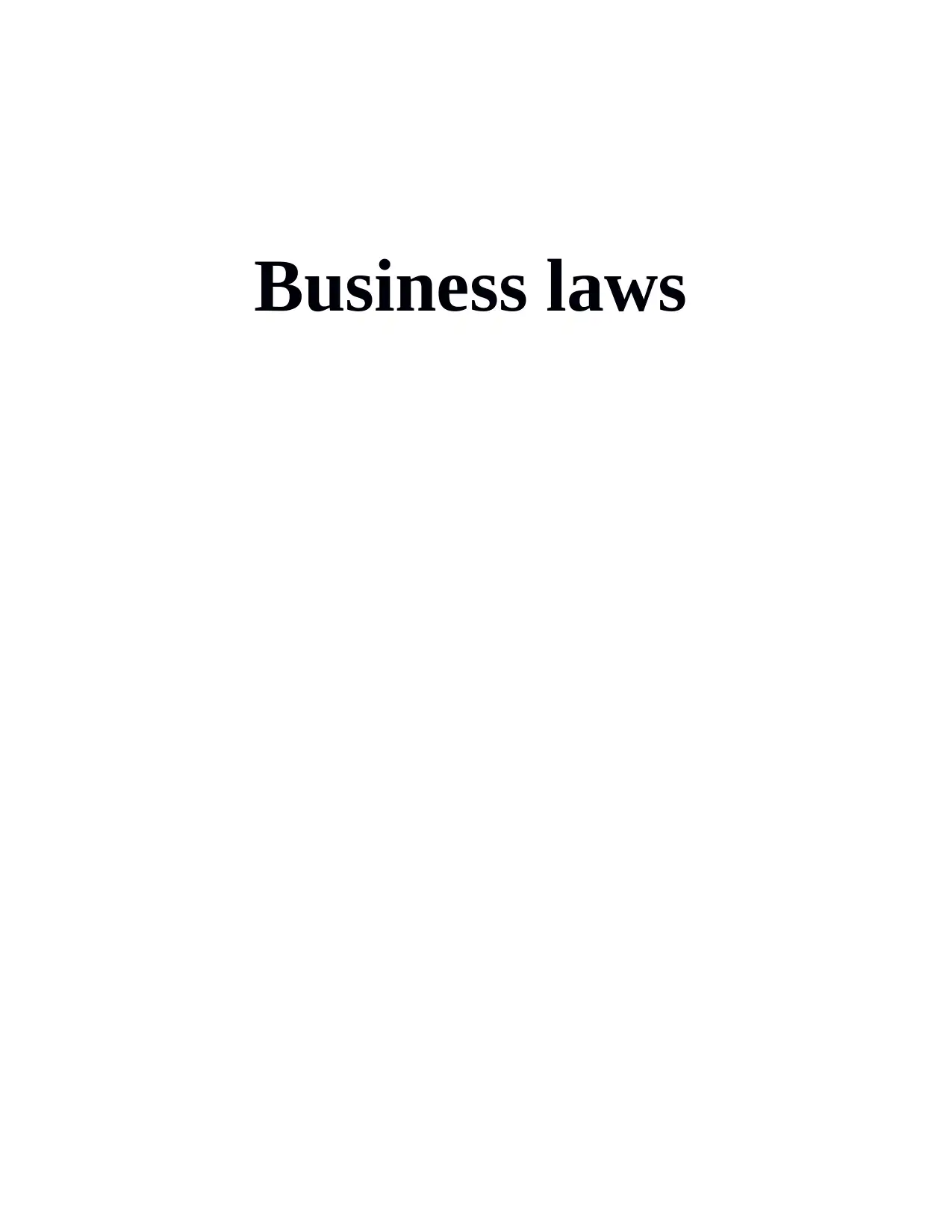
Business laws
Paraphrase This Document
Need a fresh take? Get an instant paraphrase of this document with our AI Paraphraser
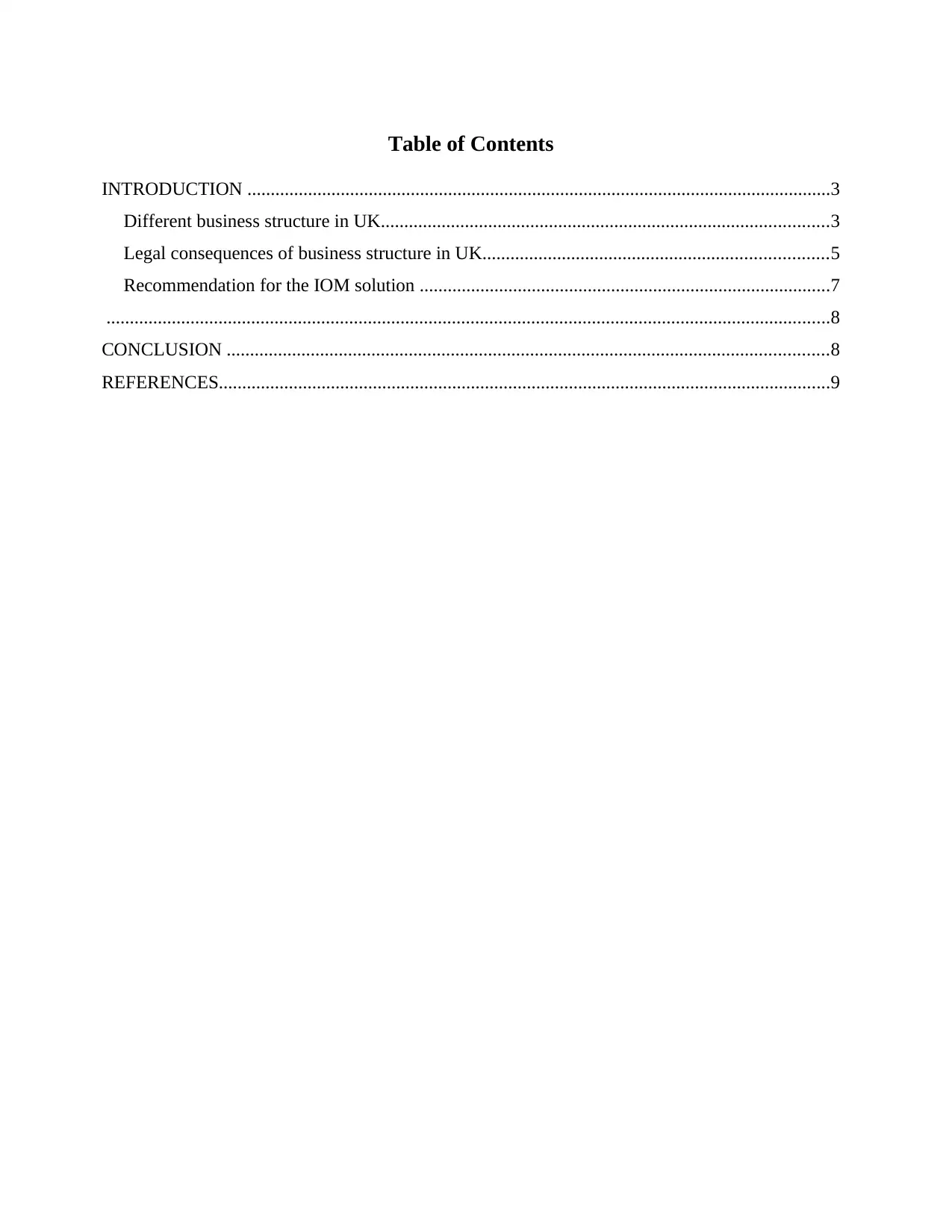
Table of Contents
INTRODUCTION .............................................................................................................................3
Different business structure in UK................................................................................................3
Legal consequences of business structure in UK..........................................................................5
Recommendation for the IOM solution ........................................................................................7
...........................................................................................................................................................8
CONCLUSION .................................................................................................................................8
REFERENCES...................................................................................................................................9
INTRODUCTION .............................................................................................................................3
Different business structure in UK................................................................................................3
Legal consequences of business structure in UK..........................................................................5
Recommendation for the IOM solution ........................................................................................7
...........................................................................................................................................................8
CONCLUSION .................................................................................................................................8
REFERENCES...................................................................................................................................9
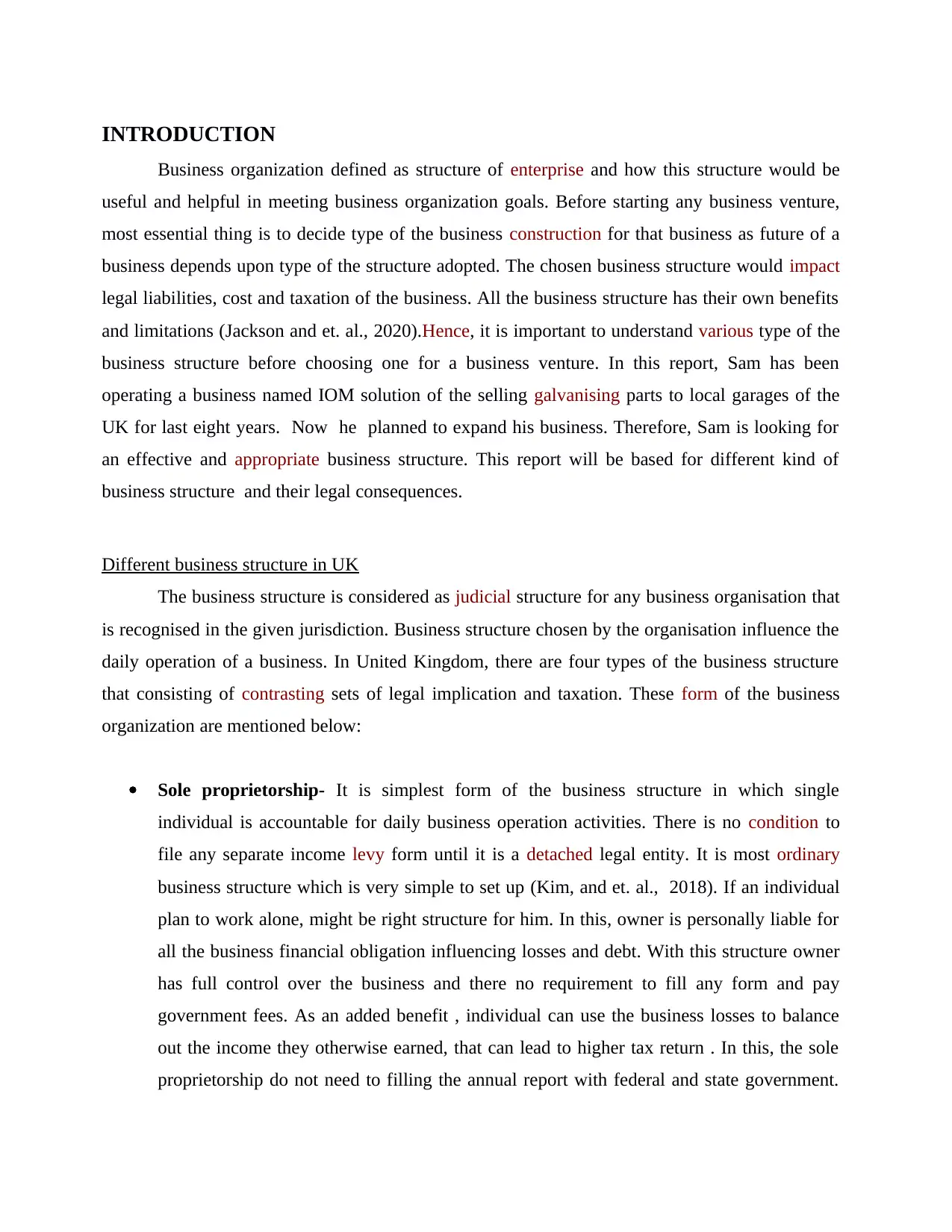
INTRODUCTION
Business organization defined as structure of enterprise and how this structure would be
useful and helpful in meeting business organization goals. Before starting any business venture,
most essential thing is to decide type of the business construction for that business as future of a
business depends upon type of the structure adopted. The chosen business structure would impact
legal liabilities, cost and taxation of the business. All the business structure has their own benefits
and limitations (Jackson and et. al., 2020).Hence, it is important to understand various type of the
business structure before choosing one for a business venture. In this report, Sam has been
operating a business named IOM solution of the selling galvanising parts to local garages of the
UK for last eight years. Now he planned to expand his business. Therefore, Sam is looking for
an effective and appropriate business structure. This report will be based for different kind of
business structure and their legal consequences.
Different business structure in UK
The business structure is considered as judicial structure for any business organisation that
is recognised in the given jurisdiction. Business structure chosen by the organisation influence the
daily operation of a business. In United Kingdom, there are four types of the business structure
that consisting of contrasting sets of legal implication and taxation. These form of the business
organization are mentioned below:
Sole proprietorship- It is simplest form of the business structure in which single
individual is accountable for daily business operation activities. There is no condition to
file any separate income levy form until it is a detached legal entity. It is most ordinary
business structure which is very simple to set up (Kim, and et. al., 2018). If an individual
plan to work alone, might be right structure for him. In this, owner is personally liable for
all the business financial obligation influencing losses and debt. With this structure owner
has full control over the business and there no requirement to fill any form and pay
government fees. As an added benefit , individual can use the business losses to balance
out the income they otherwise earned, that can lead to higher tax return . In this, the sole
proprietorship do not need to filling the annual report with federal and state government.
Business organization defined as structure of enterprise and how this structure would be
useful and helpful in meeting business organization goals. Before starting any business venture,
most essential thing is to decide type of the business construction for that business as future of a
business depends upon type of the structure adopted. The chosen business structure would impact
legal liabilities, cost and taxation of the business. All the business structure has their own benefits
and limitations (Jackson and et. al., 2020).Hence, it is important to understand various type of the
business structure before choosing one for a business venture. In this report, Sam has been
operating a business named IOM solution of the selling galvanising parts to local garages of the
UK for last eight years. Now he planned to expand his business. Therefore, Sam is looking for
an effective and appropriate business structure. This report will be based for different kind of
business structure and their legal consequences.
Different business structure in UK
The business structure is considered as judicial structure for any business organisation that
is recognised in the given jurisdiction. Business structure chosen by the organisation influence the
daily operation of a business. In United Kingdom, there are four types of the business structure
that consisting of contrasting sets of legal implication and taxation. These form of the business
organization are mentioned below:
Sole proprietorship- It is simplest form of the business structure in which single
individual is accountable for daily business operation activities. There is no condition to
file any separate income levy form until it is a detached legal entity. It is most ordinary
business structure which is very simple to set up (Kim, and et. al., 2018). If an individual
plan to work alone, might be right structure for him. In this, owner is personally liable for
all the business financial obligation influencing losses and debt. With this structure owner
has full control over the business and there no requirement to fill any form and pay
government fees. As an added benefit , individual can use the business losses to balance
out the income they otherwise earned, that can lead to higher tax return . In this, the sole
proprietorship do not need to filling the annual report with federal and state government.
⊘ This is a preview!⊘
Do you want full access?
Subscribe today to unlock all pages.

Trusted by 1+ million students worldwide
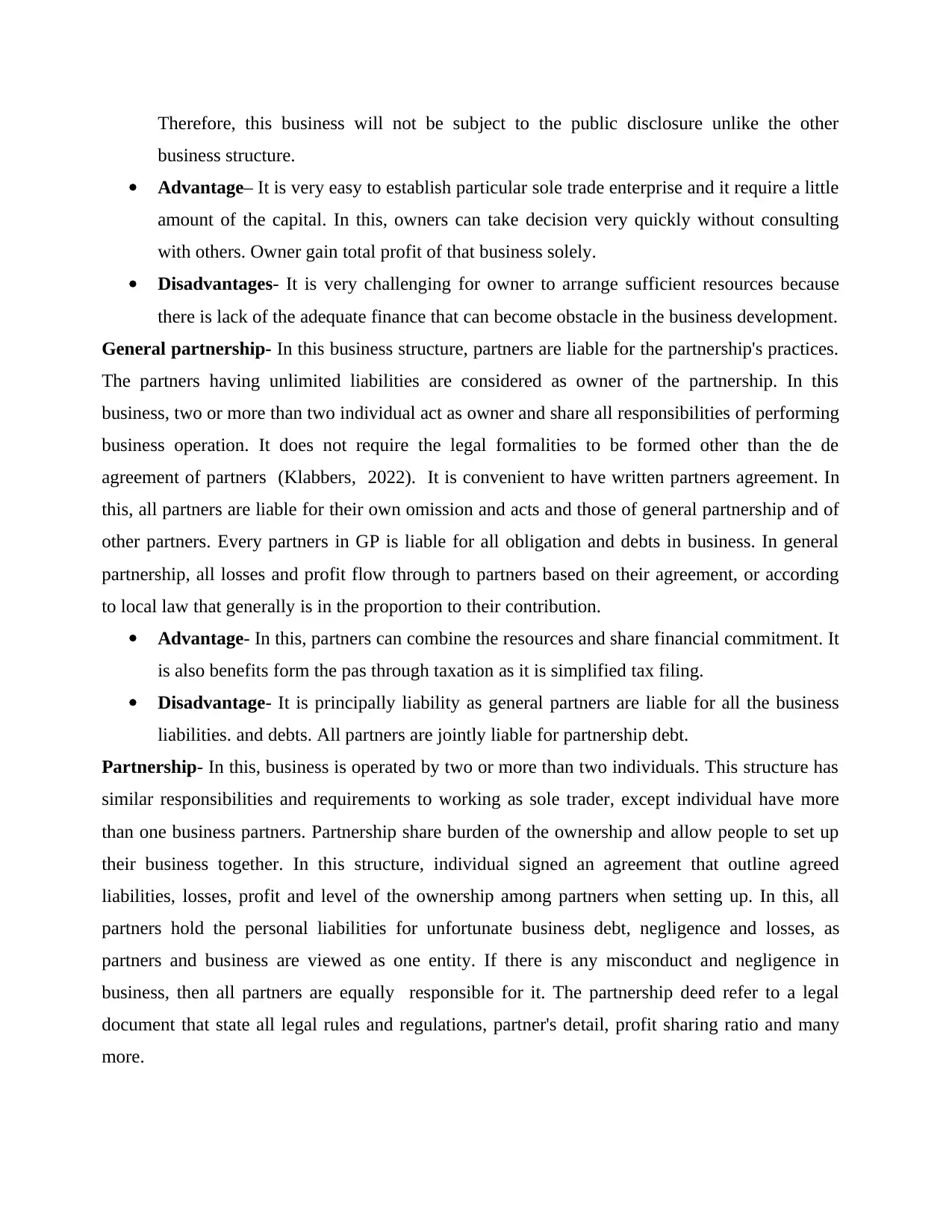
Therefore, this business will not be subject to the public disclosure unlike the other
business structure.
Advantage– It is very easy to establish particular sole trade enterprise and it require a little
amount of the capital. In this, owners can take decision very quickly without consulting
with others. Owner gain total profit of that business solely.
Disadvantages- It is very challenging for owner to arrange sufficient resources because
there is lack of the adequate finance that can become obstacle in the business development.
General partnership- In this business structure, partners are liable for the partnership's practices.
The partners having unlimited liabilities are considered as owner of the partnership. In this
business, two or more than two individual act as owner and share all responsibilities of performing
business operation. It does not require the legal formalities to be formed other than the de
agreement of partners (Klabbers, 2022). It is convenient to have written partners agreement. In
this, all partners are liable for their own omission and acts and those of general partnership and of
other partners. Every partners in GP is liable for all obligation and debts in business. In general
partnership, all losses and profit flow through to partners based on their agreement, or according
to local law that generally is in the proportion to their contribution.
Advantage- In this, partners can combine the resources and share financial commitment. It
is also benefits form the pas through taxation as it is simplified tax filing.
Disadvantage- It is principally liability as general partners are liable for all the business
liabilities. and debts. All partners are jointly liable for partnership debt.
Partnership- In this, business is operated by two or more than two individuals. This structure has
similar responsibilities and requirements to working as sole trader, except individual have more
than one business partners. Partnership share burden of the ownership and allow people to set up
their business together. In this structure, individual signed an agreement that outline agreed
liabilities, losses, profit and level of the ownership among partners when setting up. In this, all
partners hold the personal liabilities for unfortunate business debt, negligence and losses, as
partners and business are viewed as one entity. If there is any misconduct and negligence in
business, then all partners are equally responsible for it. The partnership deed refer to a legal
document that state all legal rules and regulations, partner's detail, profit sharing ratio and many
more.
business structure.
Advantage– It is very easy to establish particular sole trade enterprise and it require a little
amount of the capital. In this, owners can take decision very quickly without consulting
with others. Owner gain total profit of that business solely.
Disadvantages- It is very challenging for owner to arrange sufficient resources because
there is lack of the adequate finance that can become obstacle in the business development.
General partnership- In this business structure, partners are liable for the partnership's practices.
The partners having unlimited liabilities are considered as owner of the partnership. In this
business, two or more than two individual act as owner and share all responsibilities of performing
business operation. It does not require the legal formalities to be formed other than the de
agreement of partners (Klabbers, 2022). It is convenient to have written partners agreement. In
this, all partners are liable for their own omission and acts and those of general partnership and of
other partners. Every partners in GP is liable for all obligation and debts in business. In general
partnership, all losses and profit flow through to partners based on their agreement, or according
to local law that generally is in the proportion to their contribution.
Advantage- In this, partners can combine the resources and share financial commitment. It
is also benefits form the pas through taxation as it is simplified tax filing.
Disadvantage- It is principally liability as general partners are liable for all the business
liabilities. and debts. All partners are jointly liable for partnership debt.
Partnership- In this, business is operated by two or more than two individuals. This structure has
similar responsibilities and requirements to working as sole trader, except individual have more
than one business partners. Partnership share burden of the ownership and allow people to set up
their business together. In this structure, individual signed an agreement that outline agreed
liabilities, losses, profit and level of the ownership among partners when setting up. In this, all
partners hold the personal liabilities for unfortunate business debt, negligence and losses, as
partners and business are viewed as one entity. If there is any misconduct and negligence in
business, then all partners are equally responsible for it. The partnership deed refer to a legal
document that state all legal rules and regulations, partner's detail, profit sharing ratio and many
more.
Paraphrase This Document
Need a fresh take? Get an instant paraphrase of this document with our AI Paraphraser
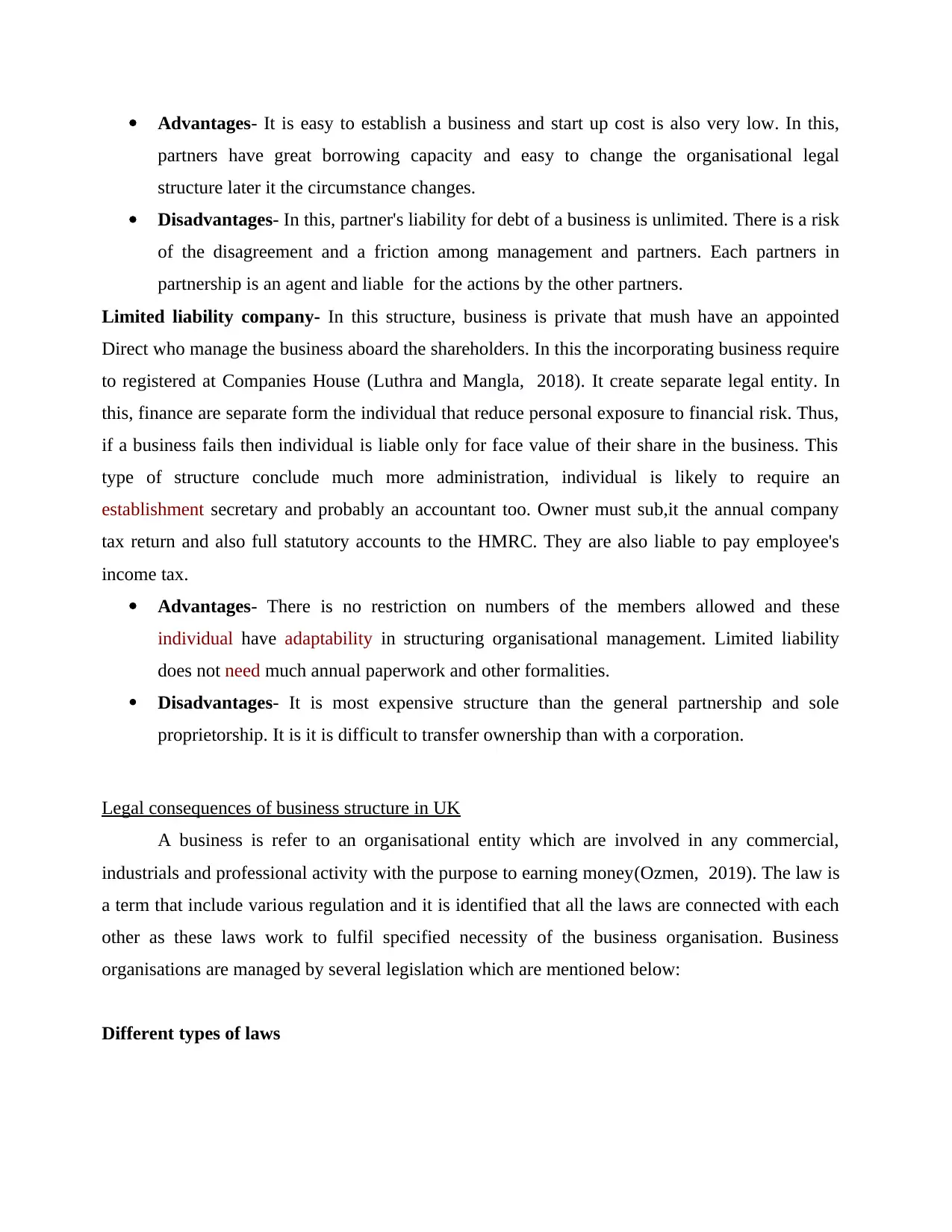
Advantages- It is easy to establish a business and start up cost is also very low. In this,
partners have great borrowing capacity and easy to change the organisational legal
structure later it the circumstance changes.
Disadvantages- In this, partner's liability for debt of a business is unlimited. There is a risk
of the disagreement and a friction among management and partners. Each partners in
partnership is an agent and liable for the actions by the other partners.
Limited liability company- In this structure, business is private that mush have an appointed
Direct who manage the business aboard the shareholders. In this the incorporating business require
to registered at Companies House (Luthra and Mangla, 2018). It create separate legal entity. In
this, finance are separate form the individual that reduce personal exposure to financial risk. Thus,
if a business fails then individual is liable only for face value of their share in the business. This
type of structure conclude much more administration, individual is likely to require an
establishment secretary and probably an accountant too. Owner must sub,it the annual company
tax return and also full statutory accounts to the HMRC. They are also liable to pay employee's
income tax.
Advantages- There is no restriction on numbers of the members allowed and these
individual have adaptability in structuring organisational management. Limited liability
does not need much annual paperwork and other formalities.
Disadvantages- It is most expensive structure than the general partnership and sole
proprietorship. It is it is difficult to transfer ownership than with a corporation.
Legal consequences of business structure in UK
A business is refer to an organisational entity which are involved in any commercial,
industrials and professional activity with the purpose to earning money(Ozmen, 2019). The law is
a term that include various regulation and it is identified that all the laws are connected with each
other as these laws work to fulfil specified necessity of the business organisation. Business
organisations are managed by several legislation which are mentioned below:
Different types of laws
partners have great borrowing capacity and easy to change the organisational legal
structure later it the circumstance changes.
Disadvantages- In this, partner's liability for debt of a business is unlimited. There is a risk
of the disagreement and a friction among management and partners. Each partners in
partnership is an agent and liable for the actions by the other partners.
Limited liability company- In this structure, business is private that mush have an appointed
Direct who manage the business aboard the shareholders. In this the incorporating business require
to registered at Companies House (Luthra and Mangla, 2018). It create separate legal entity. In
this, finance are separate form the individual that reduce personal exposure to financial risk. Thus,
if a business fails then individual is liable only for face value of their share in the business. This
type of structure conclude much more administration, individual is likely to require an
establishment secretary and probably an accountant too. Owner must sub,it the annual company
tax return and also full statutory accounts to the HMRC. They are also liable to pay employee's
income tax.
Advantages- There is no restriction on numbers of the members allowed and these
individual have adaptability in structuring organisational management. Limited liability
does not need much annual paperwork and other formalities.
Disadvantages- It is most expensive structure than the general partnership and sole
proprietorship. It is it is difficult to transfer ownership than with a corporation.
Legal consequences of business structure in UK
A business is refer to an organisational entity which are involved in any commercial,
industrials and professional activity with the purpose to earning money(Ozmen, 2019). The law is
a term that include various regulation and it is identified that all the laws are connected with each
other as these laws work to fulfil specified necessity of the business organisation. Business
organisations are managed by several legislation which are mentioned below:
Different types of laws
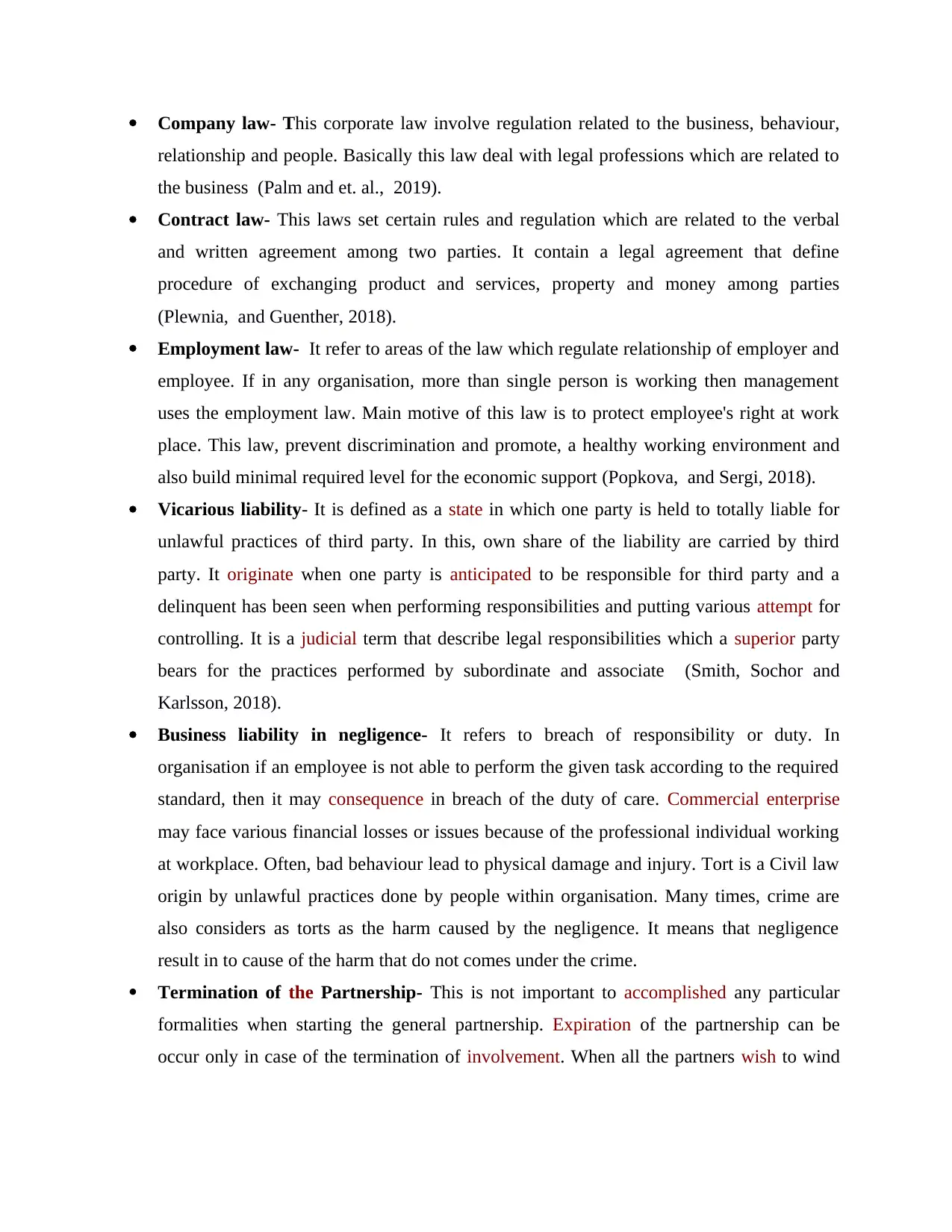
Company law- This corporate law involve regulation related to the business, behaviour,
relationship and people. Basically this law deal with legal professions which are related to
the business (Palm and et. al., 2019).
Contract law- This laws set certain rules and regulation which are related to the verbal
and written agreement among two parties. It contain a legal agreement that define
procedure of exchanging product and services, property and money among parties
(Plewnia, and Guenther, 2018).
Employment law- It refer to areas of the law which regulate relationship of employer and
employee. If in any organisation, more than single person is working then management
uses the employment law. Main motive of this law is to protect employee's right at work
place. This law, prevent discrimination and promote, a healthy working environment and
also build minimal required level for the economic support (Popkova, and Sergi, 2018).
Vicarious liability- It is defined as a state in which one party is held to totally liable for
unlawful practices of third party. In this, own share of the liability are carried by third
party. It originate when one party is anticipated to be responsible for third party and a
delinquent has been seen when performing responsibilities and putting various attempt for
controlling. It is a judicial term that describe legal responsibilities which a superior party
bears for the practices performed by subordinate and associate (Smith, Sochor and
Karlsson, 2018).
Business liability in negligence- It refers to breach of responsibility or duty. In
organisation if an employee is not able to perform the given task according to the required
standard, then it may consequence in breach of the duty of care. Commercial enterprise
may face various financial losses or issues because of the professional individual working
at workplace. Often, bad behaviour lead to physical damage and injury. Tort is a Civil law
origin by unlawful practices done by people within organisation. Many times, crime are
also considers as torts as the harm caused by the negligence. It means that negligence
result in to cause of the harm that do not comes under the crime.
Termination of the Partnership- This is not important to accomplished any particular
formalities when starting the general partnership. Expiration of the partnership can be
occur only in case of the termination of involvement. When all the partners wish to wind
relationship and people. Basically this law deal with legal professions which are related to
the business (Palm and et. al., 2019).
Contract law- This laws set certain rules and regulation which are related to the verbal
and written agreement among two parties. It contain a legal agreement that define
procedure of exchanging product and services, property and money among parties
(Plewnia, and Guenther, 2018).
Employment law- It refer to areas of the law which regulate relationship of employer and
employee. If in any organisation, more than single person is working then management
uses the employment law. Main motive of this law is to protect employee's right at work
place. This law, prevent discrimination and promote, a healthy working environment and
also build minimal required level for the economic support (Popkova, and Sergi, 2018).
Vicarious liability- It is defined as a state in which one party is held to totally liable for
unlawful practices of third party. In this, own share of the liability are carried by third
party. It originate when one party is anticipated to be responsible for third party and a
delinquent has been seen when performing responsibilities and putting various attempt for
controlling. It is a judicial term that describe legal responsibilities which a superior party
bears for the practices performed by subordinate and associate (Smith, Sochor and
Karlsson, 2018).
Business liability in negligence- It refers to breach of responsibility or duty. In
organisation if an employee is not able to perform the given task according to the required
standard, then it may consequence in breach of the duty of care. Commercial enterprise
may face various financial losses or issues because of the professional individual working
at workplace. Often, bad behaviour lead to physical damage and injury. Tort is a Civil law
origin by unlawful practices done by people within organisation. Many times, crime are
also considers as torts as the harm caused by the negligence. It means that negligence
result in to cause of the harm that do not comes under the crime.
Termination of the Partnership- This is not important to accomplished any particular
formalities when starting the general partnership. Expiration of the partnership can be
occur only in case of the termination of involvement. When all the partners wish to wind
⊘ This is a preview!⊘
Do you want full access?
Subscribe today to unlock all pages.

Trusted by 1+ million students worldwide
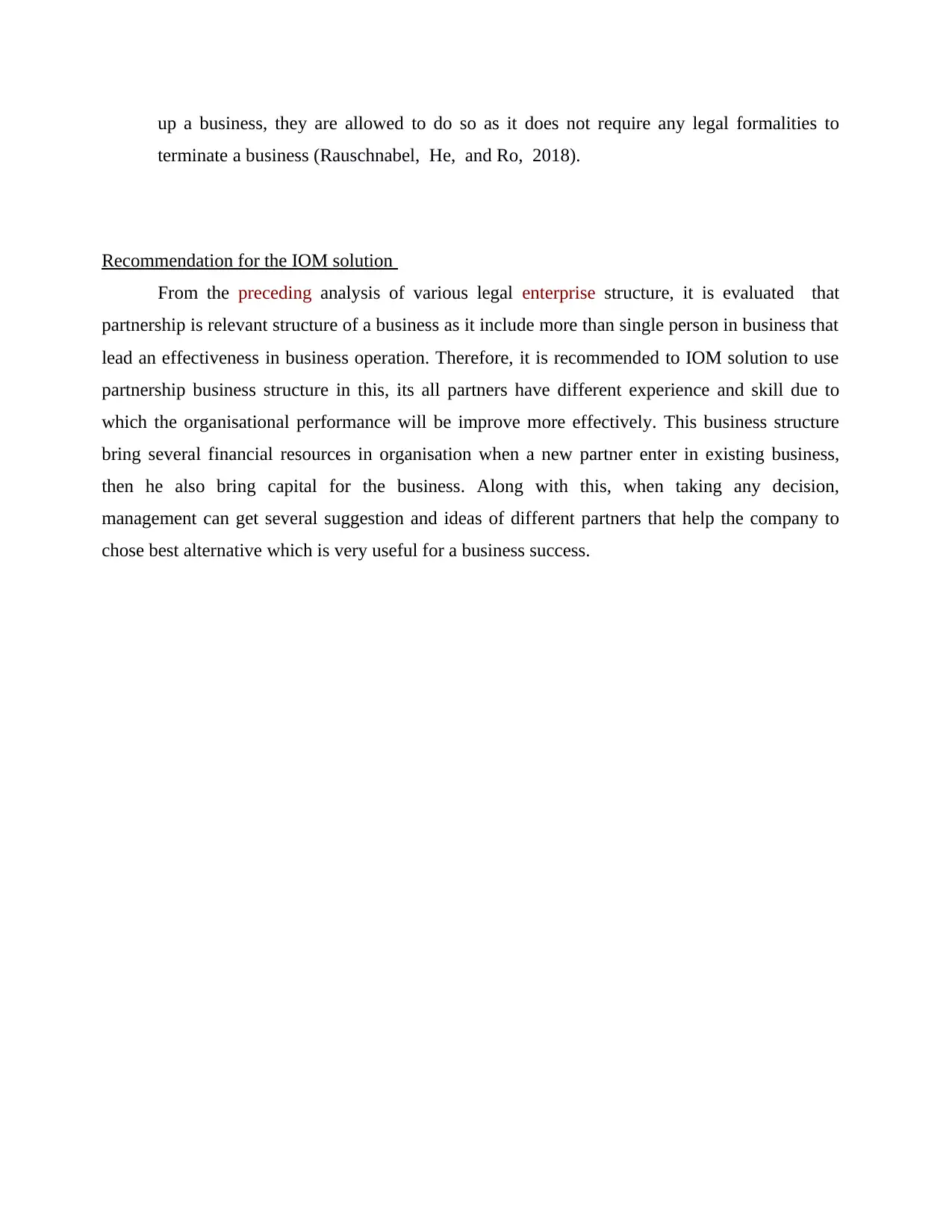
up a business, they are allowed to do so as it does not require any legal formalities to
terminate a business (Rauschnabel, He, and Ro, 2018).
Recommendation for the IOM solution
From the preceding analysis of various legal enterprise structure, it is evaluated that
partnership is relevant structure of a business as it include more than single person in business that
lead an effectiveness in business operation. Therefore, it is recommended to IOM solution to use
partnership business structure in this, its all partners have different experience and skill due to
which the organisational performance will be improve more effectively. This business structure
bring several financial resources in organisation when a new partner enter in existing business,
then he also bring capital for the business. Along with this, when taking any decision,
management can get several suggestion and ideas of different partners that help the company to
chose best alternative which is very useful for a business success.
terminate a business (Rauschnabel, He, and Ro, 2018).
Recommendation for the IOM solution
From the preceding analysis of various legal enterprise structure, it is evaluated that
partnership is relevant structure of a business as it include more than single person in business that
lead an effectiveness in business operation. Therefore, it is recommended to IOM solution to use
partnership business structure in this, its all partners have different experience and skill due to
which the organisational performance will be improve more effectively. This business structure
bring several financial resources in organisation when a new partner enter in existing business,
then he also bring capital for the business. Along with this, when taking any decision,
management can get several suggestion and ideas of different partners that help the company to
chose best alternative which is very useful for a business success.
Paraphrase This Document
Need a fresh take? Get an instant paraphrase of this document with our AI Paraphraser
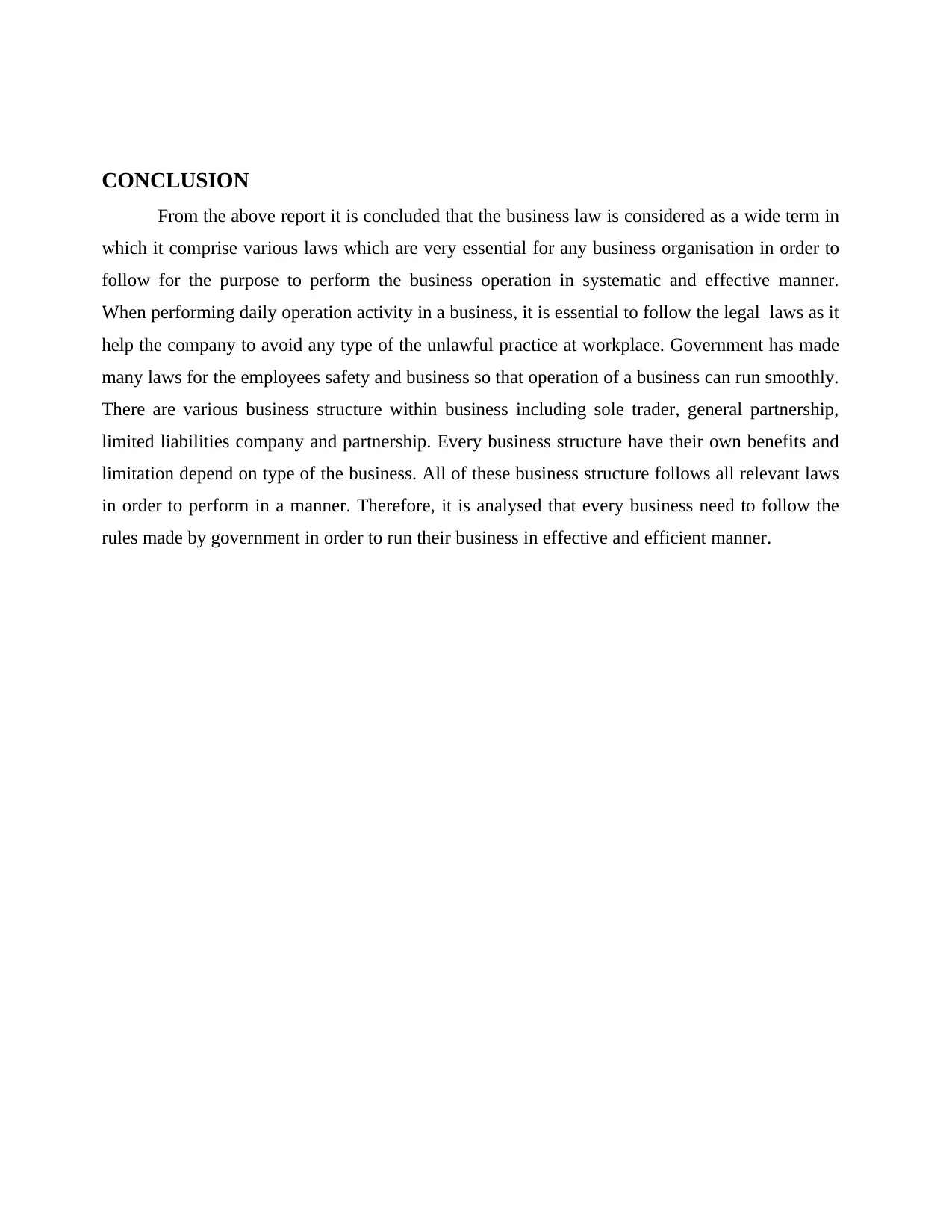
CONCLUSION
From the above report it is concluded that the business law is considered as a wide term in
which it comprise various laws which are very essential for any business organisation in order to
follow for the purpose to perform the business operation in systematic and effective manner.
When performing daily operation activity in a business, it is essential to follow the legal laws as it
help the company to avoid any type of the unlawful practice at workplace. Government has made
many laws for the employees safety and business so that operation of a business can run smoothly.
There are various business structure within business including sole trader, general partnership,
limited liabilities company and partnership. Every business structure have their own benefits and
limitation depend on type of the business. All of these business structure follows all relevant laws
in order to perform in a manner. Therefore, it is analysed that every business need to follow the
rules made by government in order to run their business in effective and efficient manner.
From the above report it is concluded that the business law is considered as a wide term in
which it comprise various laws which are very essential for any business organisation in order to
follow for the purpose to perform the business operation in systematic and effective manner.
When performing daily operation activity in a business, it is essential to follow the legal laws as it
help the company to avoid any type of the unlawful practice at workplace. Government has made
many laws for the employees safety and business so that operation of a business can run smoothly.
There are various business structure within business including sole trader, general partnership,
limited liabilities company and partnership. Every business structure have their own benefits and
limitation depend on type of the business. All of these business structure follows all relevant laws
in order to perform in a manner. Therefore, it is analysed that every business need to follow the
rules made by government in order to run their business in effective and efficient manner.
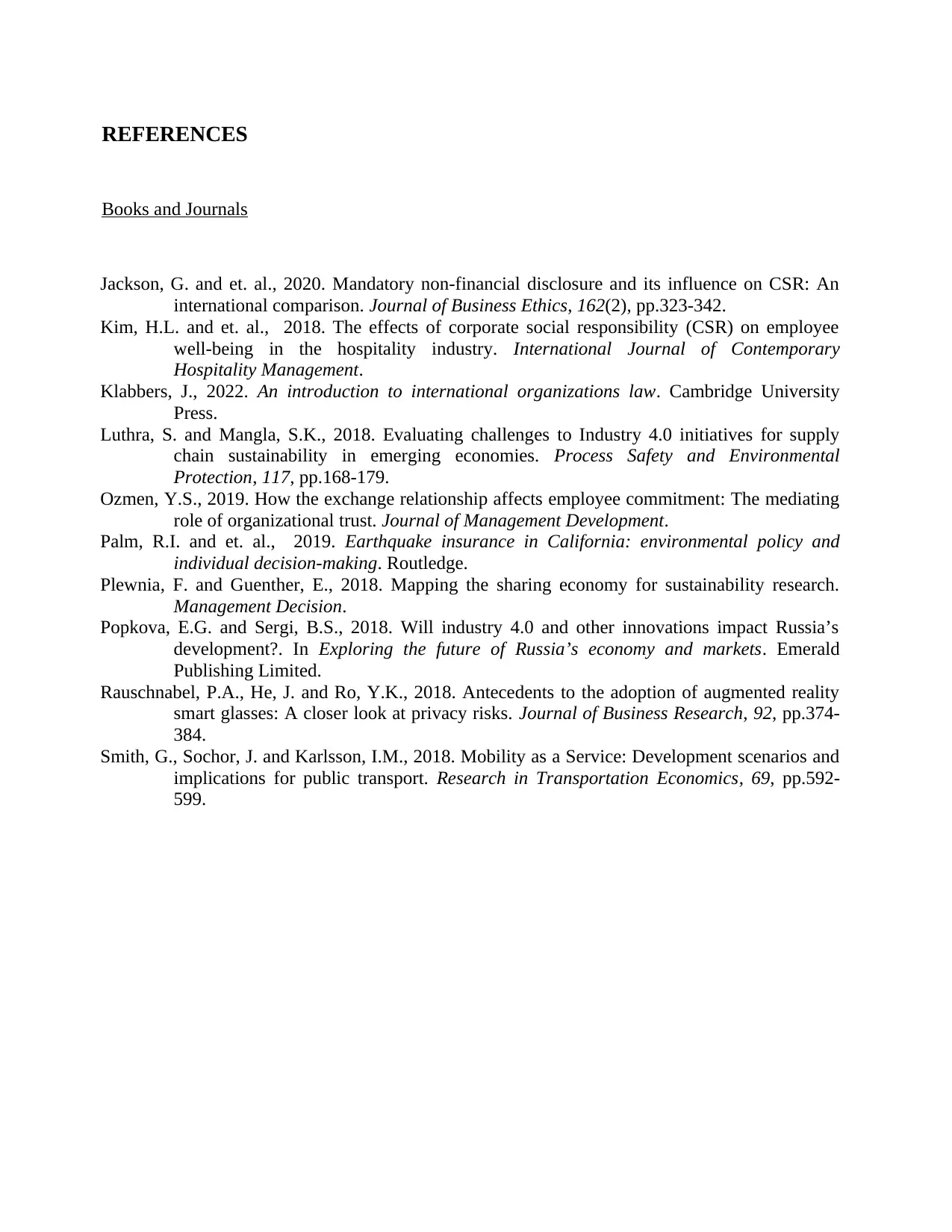
REFERENCES
Books and Journals
Jackson, G. and et. al., 2020. Mandatory non-financial disclosure and its influence on CSR: An
international comparison. Journal of Business Ethics, 162(2), pp.323-342.
Kim, H.L. and et. al., 2018. The effects of corporate social responsibility (CSR) on employee
well-being in the hospitality industry. International Journal of Contemporary
Hospitality Management.
Klabbers, J., 2022. An introduction to international organizations law. Cambridge University
Press.
Luthra, S. and Mangla, S.K., 2018. Evaluating challenges to Industry 4.0 initiatives for supply
chain sustainability in emerging economies. Process Safety and Environmental
Protection, 117, pp.168-179.
Ozmen, Y.S., 2019. How the exchange relationship affects employee commitment: The mediating
role of organizational trust. Journal of Management Development.
Palm, R.I. and et. al., 2019. Earthquake insurance in California: environmental policy and
individual decision-making. Routledge.
Plewnia, F. and Guenther, E., 2018. Mapping the sharing economy for sustainability research.
Management Decision.
Popkova, E.G. and Sergi, B.S., 2018. Will industry 4.0 and other innovations impact Russia’s
development?. In Exploring the future of Russia’s economy and markets. Emerald
Publishing Limited.
Rauschnabel, P.A., He, J. and Ro, Y.K., 2018. Antecedents to the adoption of augmented reality
smart glasses: A closer look at privacy risks. Journal of Business Research, 92, pp.374-
384.
Smith, G., Sochor, J. and Karlsson, I.M., 2018. Mobility as a Service: Development scenarios and
implications for public transport. Research in Transportation Economics, 69, pp.592-
599.
Books and Journals
Jackson, G. and et. al., 2020. Mandatory non-financial disclosure and its influence on CSR: An
international comparison. Journal of Business Ethics, 162(2), pp.323-342.
Kim, H.L. and et. al., 2018. The effects of corporate social responsibility (CSR) on employee
well-being in the hospitality industry. International Journal of Contemporary
Hospitality Management.
Klabbers, J., 2022. An introduction to international organizations law. Cambridge University
Press.
Luthra, S. and Mangla, S.K., 2018. Evaluating challenges to Industry 4.0 initiatives for supply
chain sustainability in emerging economies. Process Safety and Environmental
Protection, 117, pp.168-179.
Ozmen, Y.S., 2019. How the exchange relationship affects employee commitment: The mediating
role of organizational trust. Journal of Management Development.
Palm, R.I. and et. al., 2019. Earthquake insurance in California: environmental policy and
individual decision-making. Routledge.
Plewnia, F. and Guenther, E., 2018. Mapping the sharing economy for sustainability research.
Management Decision.
Popkova, E.G. and Sergi, B.S., 2018. Will industry 4.0 and other innovations impact Russia’s
development?. In Exploring the future of Russia’s economy and markets. Emerald
Publishing Limited.
Rauschnabel, P.A., He, J. and Ro, Y.K., 2018. Antecedents to the adoption of augmented reality
smart glasses: A closer look at privacy risks. Journal of Business Research, 92, pp.374-
384.
Smith, G., Sochor, J. and Karlsson, I.M., 2018. Mobility as a Service: Development scenarios and
implications for public transport. Research in Transportation Economics, 69, pp.592-
599.
⊘ This is a preview!⊘
Do you want full access?
Subscribe today to unlock all pages.

Trusted by 1+ million students worldwide

1 out of 10
Related Documents
Your All-in-One AI-Powered Toolkit for Academic Success.
+13062052269
info@desklib.com
Available 24*7 on WhatsApp / Email
![[object Object]](/_next/static/media/star-bottom.7253800d.svg)
Unlock your academic potential
Copyright © 2020–2025 A2Z Services. All Rights Reserved. Developed and managed by ZUCOL.





